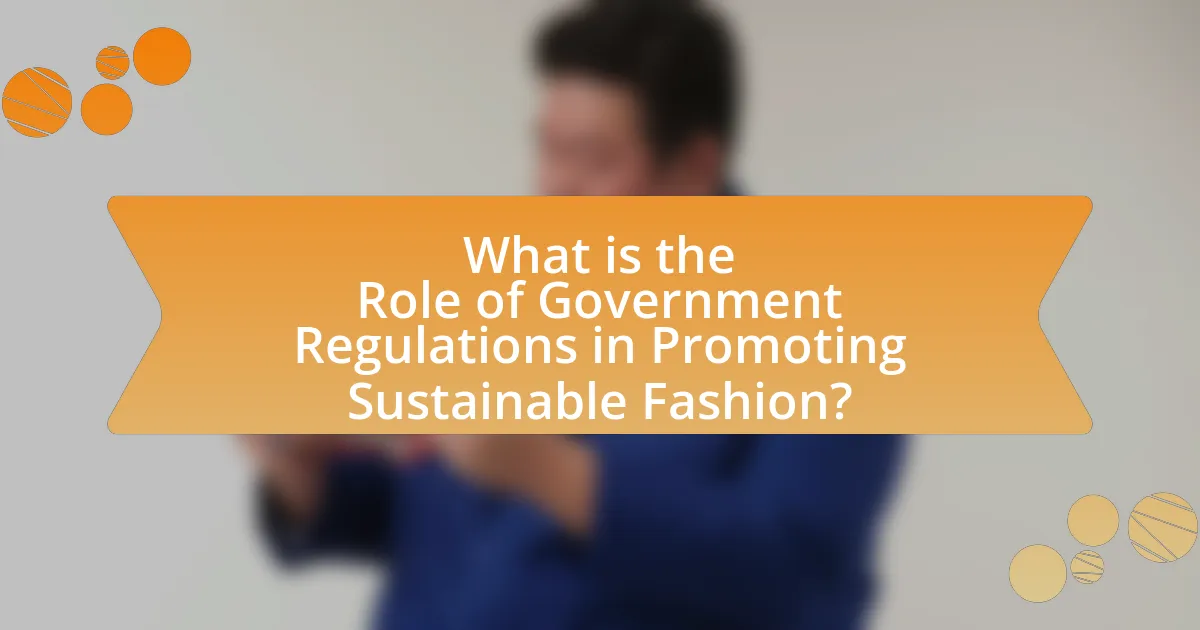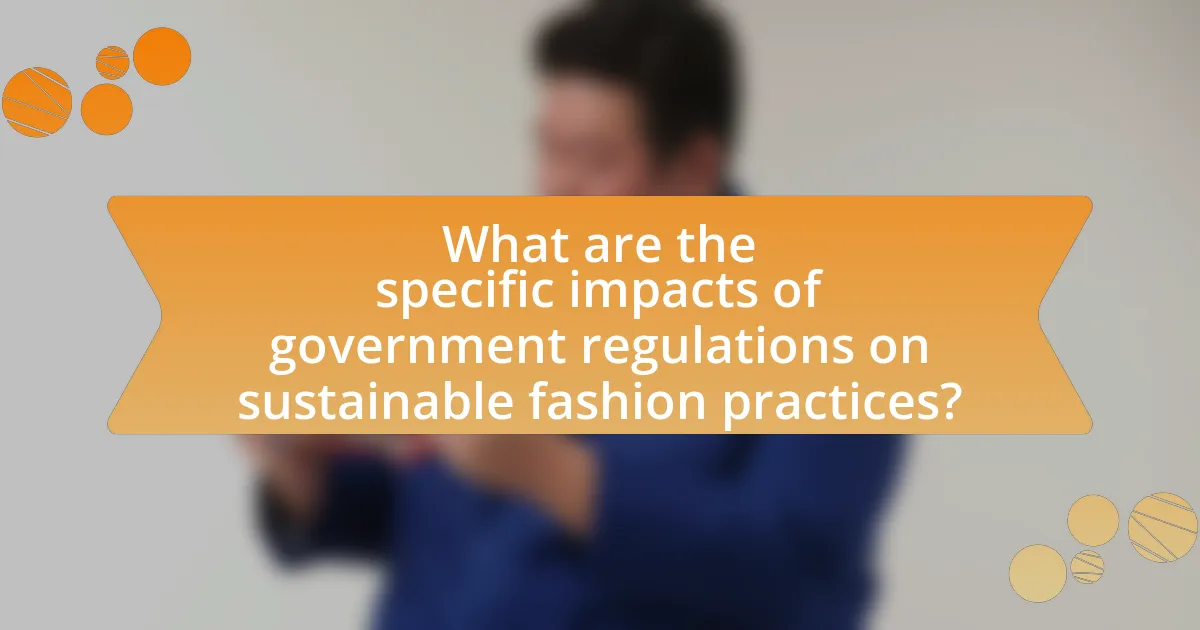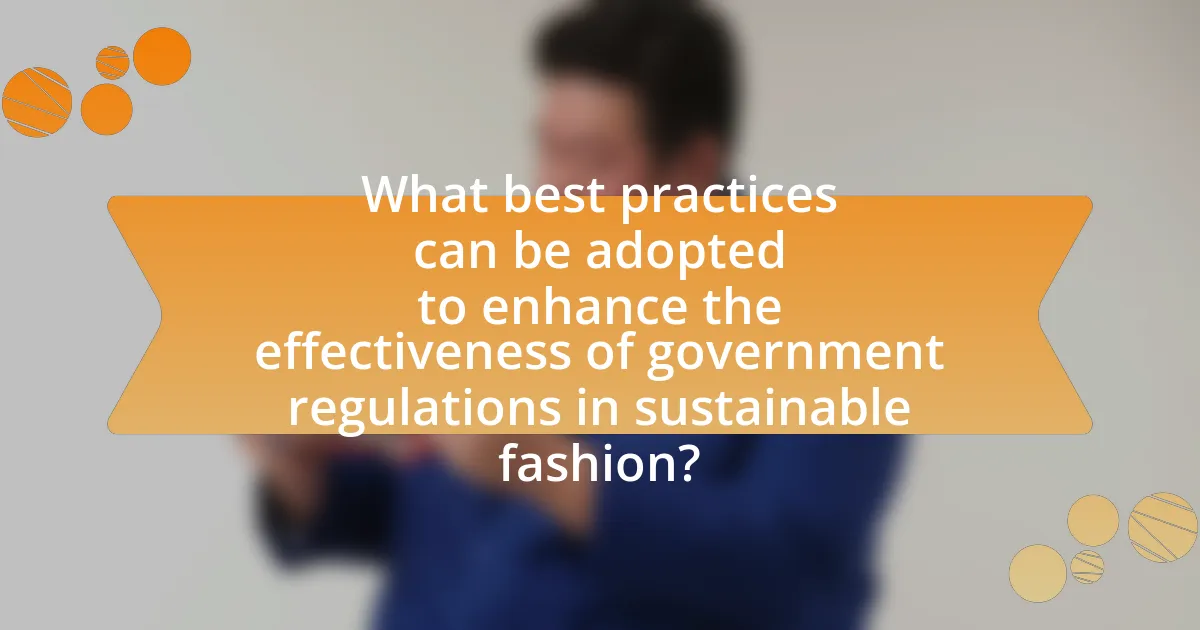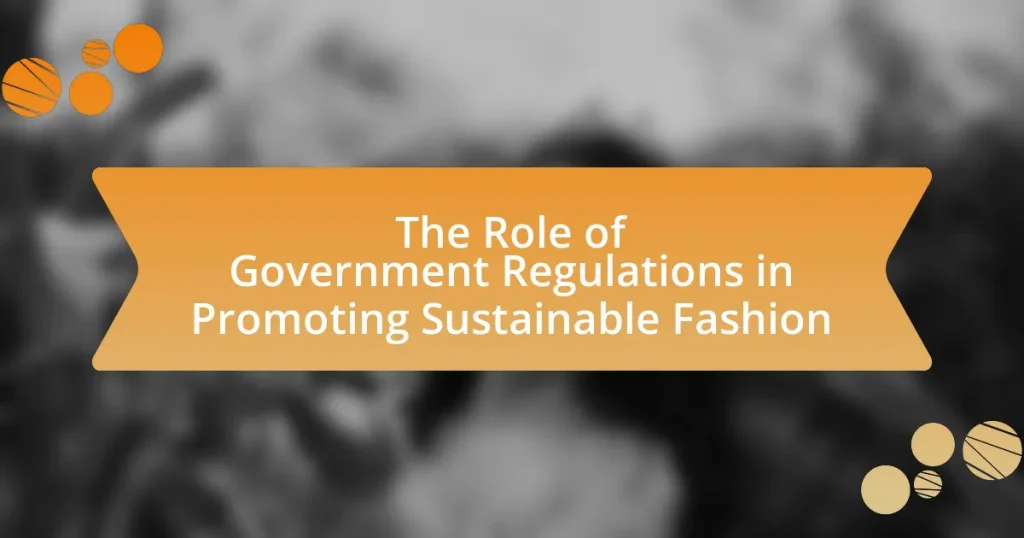The article examines the critical role of government regulations in promoting sustainable fashion, highlighting how these regulations establish standards for environmental sustainability, labor practices, and consumer safety. It discusses various types of regulations, such as environmental standards and labor laws, and their influence on fashion brands and consumer behavior. The article also addresses the challenges governments face in enforcing these regulations, the economic impacts on fashion brands, and the importance of stakeholder engagement in shaping effective policies. Additionally, it emphasizes the need for transparency and education to enhance compliance and drive sustainable practices within the fashion industry.

What is the Role of Government Regulations in Promoting Sustainable Fashion?
Government regulations play a crucial role in promoting sustainable fashion by establishing standards that manufacturers must adhere to, thereby encouraging environmentally friendly practices. These regulations can include requirements for reduced waste, limits on harmful chemicals, and mandates for transparency in supply chains. For instance, the European Union’s Green Deal aims to make the fashion industry more sustainable by enforcing stricter environmental standards and promoting circular economy principles. Such regulations not only incentivize brands to adopt sustainable practices but also protect consumers and the environment by ensuring that products meet specific sustainability criteria.
How do government regulations influence the fashion industry?
Government regulations significantly influence the fashion industry by establishing standards for environmental sustainability, labor practices, and consumer safety. These regulations compel fashion brands to adopt sustainable practices, such as reducing waste and using eco-friendly materials, to comply with laws like the European Union’s REACH regulation, which restricts harmful substances in textiles. Additionally, labor regulations, such as the Fair Labor Standards Act in the United States, mandate fair wages and safe working conditions, pushing companies to ensure ethical practices in their supply chains. Compliance with these regulations not only helps protect the environment and workers but also enhances brand reputation and consumer trust, as evidenced by a 2021 McKinsey report indicating that 67% of consumers consider sustainability when making purchasing decisions.
What types of regulations are implemented to promote sustainability?
Governments implement various types of regulations to promote sustainability, including environmental standards, emissions limits, and resource management policies. Environmental standards mandate specific practices for waste management and pollution control, ensuring that industries minimize their ecological footprint. Emissions limits restrict the amount of greenhouse gases that can be released into the atmosphere, directly addressing climate change. Resource management policies regulate the use of natural resources, promoting conservation and sustainable practices in sectors such as agriculture and forestry. These regulations are supported by international agreements, such as the Paris Agreement, which aims to unite countries in reducing carbon emissions and fostering sustainable development.
How do these regulations impact fashion brands and consumers?
Government regulations significantly impact fashion brands and consumers by enforcing sustainability standards that promote ethical practices. These regulations compel brands to adopt environmentally friendly materials and processes, thereby reducing waste and pollution. For instance, the European Union’s Green Deal aims to make the fashion industry more sustainable by implementing stricter guidelines on textile waste and resource use. As a result, consumers benefit from increased transparency regarding the environmental impact of their purchases, leading to more informed buying decisions. Additionally, compliance with these regulations can enhance brand reputation and consumer trust, as brands that prioritize sustainability often attract a more conscientious customer base.
Why is sustainable fashion important in today’s context?
Sustainable fashion is important in today’s context because it addresses environmental degradation and social inequality caused by the fast fashion industry. The fashion industry is responsible for approximately 10% of global carbon emissions and is a major contributor to water pollution and waste. By promoting sustainable practices, such as using eco-friendly materials and ethical labor practices, sustainable fashion reduces the negative impact on the planet and supports fair working conditions. Government regulations play a crucial role in this shift by incentivizing brands to adopt sustainable practices and holding them accountable for their environmental and social footprints.
What environmental issues does sustainable fashion address?
Sustainable fashion addresses several critical environmental issues, including waste reduction, resource depletion, and pollution. By promoting the use of eco-friendly materials and ethical production practices, sustainable fashion aims to minimize textile waste, which is a significant contributor to landfill overflow, with the fashion industry generating over 92 million tons of waste annually. Additionally, sustainable fashion seeks to reduce the consumption of water and energy, as traditional textile production is responsible for approximately 20% of global wastewater and significant greenhouse gas emissions. Furthermore, it addresses chemical pollution by advocating for the use of non-toxic dyes and sustainable manufacturing processes, which can help mitigate the harmful effects on ecosystems and human health.
How does sustainable fashion contribute to social responsibility?
Sustainable fashion contributes to social responsibility by promoting ethical labor practices and reducing environmental harm. This approach ensures that workers are treated fairly, receive adequate wages, and work in safe conditions, which aligns with social equity principles. For instance, brands that adopt sustainable practices often adhere to certifications like Fair Trade, which guarantees that producers are compensated fairly and work under humane conditions. Additionally, sustainable fashion reduces waste and pollution, addressing environmental justice issues that disproportionately affect marginalized communities. By prioritizing these values, sustainable fashion fosters a more equitable and responsible industry.
What challenges do governments face in regulating the fashion industry?
Governments face significant challenges in regulating the fashion industry, primarily due to its global nature and the complexity of supply chains. The fashion industry operates across multiple countries, making it difficult for any single government to enforce regulations effectively. For instance, the lack of standardized international labor laws leads to inconsistent enforcement of worker rights and environmental standards. Additionally, the fast-paced nature of fashion trends complicates regulatory efforts, as companies may quickly adapt to avoid compliance. Furthermore, the prevalence of informal labor and unregistered businesses in many regions hinders oversight and accountability. These factors collectively create a challenging environment for governments aiming to implement and enforce regulations that promote sustainable practices within the fashion industry.
How do varying international regulations affect global fashion brands?
Varying international regulations significantly impact global fashion brands by influencing their operational practices, compliance costs, and market access. For instance, regulations regarding labor standards, environmental sustainability, and trade tariffs differ across countries, compelling brands to adapt their supply chains and production methods. A study by the International Labour Organization highlights that stricter labor regulations in countries like Germany lead to higher compliance costs for brands operating there, which can affect pricing strategies and profit margins. Additionally, environmental regulations, such as those enforced by the European Union, require brands to adopt sustainable practices, thereby reshaping their product offerings and marketing strategies to align with consumer expectations and legal requirements.
What are the enforcement challenges in sustainable fashion regulations?
Enforcement challenges in sustainable fashion regulations include a lack of standardized metrics for sustainability, limited resources for monitoring compliance, and the complexity of global supply chains. The absence of universally accepted sustainability criteria makes it difficult for regulators to assess compliance effectively. Additionally, many regulatory bodies face budget constraints, limiting their ability to conduct thorough inspections and enforce regulations. The intricate nature of global supply chains further complicates enforcement, as brands often source materials from multiple countries with varying regulations, making it challenging to ensure adherence to sustainable practices throughout the entire production process.
How can government regulations be improved to better support sustainable fashion?
Government regulations can be improved to better support sustainable fashion by implementing stricter environmental standards and incentivizing sustainable practices. Stricter regulations can include mandatory reporting on carbon emissions and waste management for fashion companies, which would promote transparency and accountability. Additionally, providing tax breaks or subsidies for companies that utilize sustainable materials and ethical labor practices can encourage the industry to adopt more environmentally friendly methods. For instance, the European Union’s Green Deal aims to make the fashion industry more sustainable by promoting circular economy principles, which can serve as a model for other regions. These measures can lead to a significant reduction in the environmental impact of the fashion industry while fostering innovation in sustainable practices.
What role do stakeholders play in shaping effective regulations?
Stakeholders play a crucial role in shaping effective regulations by providing diverse perspectives, expertise, and feedback that inform policy development. Their involvement ensures that regulations address the needs and concerns of various groups, including businesses, consumers, and environmental advocates. For instance, in the context of sustainable fashion, stakeholders such as manufacturers, retailers, and NGOs contribute insights on best practices and potential impacts of regulations, leading to more balanced and effective outcomes. Research by the World Resources Institute highlights that stakeholder engagement in regulatory processes can enhance compliance and foster innovation, ultimately supporting the transition to sustainable practices in the fashion industry.
How can collaboration between governments and fashion brands enhance sustainability?
Collaboration between governments and fashion brands can enhance sustainability by creating regulatory frameworks that incentivize eco-friendly practices. Governments can establish standards for sustainable materials, waste management, and carbon emissions, which fashion brands must adhere to, thereby promoting responsible production. For instance, the European Union’s Green Deal aims to make the fashion industry more sustainable by implementing regulations that encourage circular economy practices, such as recycling and reducing textile waste. This collaboration not only drives innovation in sustainable materials but also ensures that brands are held accountable for their environmental impact, leading to a more sustainable fashion ecosystem.

What are the specific impacts of government regulations on sustainable fashion practices?
Government regulations significantly impact sustainable fashion practices by enforcing standards that promote environmental responsibility and ethical labor practices. These regulations can include requirements for transparency in supply chains, limits on waste and emissions, and incentives for using sustainable materials. For instance, the European Union’s Green Deal aims to make the fashion industry more sustainable by mandating eco-design requirements, which compel brands to consider the entire lifecycle of their products. Additionally, regulations like the California Transparency in Supply Chains Act require companies to disclose their efforts to eradicate slavery and human trafficking, thereby encouraging ethical labor practices. Such regulations not only drive compliance but also foster innovation in sustainable practices, as companies seek to meet these standards while appealing to environmentally conscious consumers.
How do regulations affect the supply chain in the fashion industry?
Regulations significantly impact the supply chain in the fashion industry by enforcing standards that promote sustainability and ethical practices. These regulations can include environmental laws, labor standards, and trade policies that require companies to adopt more responsible sourcing and production methods. For instance, the European Union’s Regulation on the Registration, Evaluation, Authorisation and Restriction of Chemicals (REACH) mandates that fashion brands ensure their products are free from harmful substances, thereby influencing sourcing decisions and manufacturing processes. Additionally, regulations like the California Transparency in Supply Chains Act compel companies to disclose their supply chain practices, pushing them towards greater transparency and accountability. Such legal frameworks not only shape operational strategies but also drive innovation in sustainable materials and processes within the fashion supply chain.
What are the implications for sourcing materials sustainably?
Sourcing materials sustainably has significant implications for environmental conservation, economic stability, and social equity. Sustainable sourcing reduces the depletion of natural resources, minimizes pollution, and lowers carbon emissions, contributing to climate change mitigation. For instance, according to the Ellen MacArthur Foundation, transitioning to a circular economy in fashion could reduce global greenhouse gas emissions by 44% by 2030. Economically, sustainable sourcing can lead to long-term cost savings through efficient resource use and waste reduction, while socially, it promotes fair labor practices and supports local communities. These implications highlight the critical role of sustainable sourcing in fostering a more responsible and resilient fashion industry.
How do regulations influence labor practices in fashion production?
Regulations significantly influence labor practices in fashion production by establishing legal standards that protect workers’ rights and ensure fair working conditions. For instance, labor laws mandate minimum wage, working hours, and safety standards, compelling fashion companies to comply or face penalties. The International Labour Organization (ILO) sets guidelines that many countries adopt, promoting decent work and fair treatment. Compliance with these regulations can lead to improved labor conditions, as seen in countries like Bangladesh, where the Accord on Fire and Building Safety has enhanced safety standards in garment factories. Thus, regulations serve as a critical framework for promoting ethical labor practices in the fashion industry.
What are the economic impacts of sustainable fashion regulations?
Sustainable fashion regulations can lead to both positive and negative economic impacts. On the positive side, these regulations can stimulate innovation and create new market opportunities, as companies invest in sustainable materials and processes. For instance, a report by McKinsey & Company indicates that the global sustainable fashion market could reach $8.25 billion by 2023, driven by consumer demand for eco-friendly products. Conversely, regulations may impose additional costs on manufacturers, particularly small businesses, which could lead to increased prices for consumers and potential job losses in traditional manufacturing sectors. A study from the Ellen MacArthur Foundation highlights that while transitioning to sustainable practices may incur upfront costs, the long-term benefits include reduced resource consumption and waste management expenses, ultimately contributing to a more resilient economy.
How do regulations affect the profitability of fashion brands?
Regulations significantly impact the profitability of fashion brands by imposing compliance costs and influencing operational practices. For instance, environmental regulations require brands to invest in sustainable materials and processes, which can increase production costs but may also lead to long-term savings and enhanced brand loyalty. According to a report by McKinsey & Company, brands that adopt sustainable practices can see a 10-20% increase in profitability over time due to consumer preference for eco-friendly products. Additionally, labor regulations can affect wage structures and working conditions, influencing brand reputation and consumer trust, which are critical for profitability.
What financial incentives exist for brands to comply with sustainability regulations?
Brands can benefit financially from complying with sustainability regulations through various incentives such as tax breaks, grants, and access to green financing. These financial incentives encourage brands to adopt sustainable practices by reducing operational costs and enhancing their market competitiveness. For instance, governments often provide tax credits for companies that invest in renewable energy or sustainable materials, which can significantly lower their tax liabilities. Additionally, grants and subsidies may be available for brands that implement eco-friendly technologies or practices, further alleviating financial burdens. Access to green financing options, such as low-interest loans specifically for sustainable projects, also incentivizes compliance by making it easier for brands to fund their sustainability initiatives.
How do consumer behaviors change in response to government regulations?
Consumer behaviors change significantly in response to government regulations by shifting towards more sustainable and ethical purchasing decisions. For instance, when regulations mandate transparency in supply chains, consumers become more aware of the environmental and social impacts of their purchases, leading to increased demand for sustainable fashion brands. A study by the European Commission in 2021 found that 70% of consumers are more likely to buy from brands that demonstrate compliance with environmental regulations. This indicates that government interventions can effectively influence consumer preferences and drive market trends towards sustainability.
What awareness campaigns are effective in promoting sustainable fashion?
Awareness campaigns that effectively promote sustainable fashion include initiatives like Fashion Revolution, which encourages consumers to ask brands “Who made my clothes?” This campaign raises awareness about labor practices and environmental impacts in the fashion industry. Another effective campaign is the “Wear It Again” initiative, which promotes second-hand clothing and recycling, reducing waste and encouraging sustainable consumption. Research shows that campaigns utilizing social media platforms, such as Instagram and TikTok, significantly increase engagement and awareness among younger audiences, leading to a greater understanding of sustainable practices in fashion.
How do regulations influence consumer purchasing decisions?
Regulations significantly influence consumer purchasing decisions by establishing standards that promote transparency and sustainability in products. For instance, regulations such as the EU’s Eco-Design Directive require manufacturers to consider environmental impacts, which can lead consumers to prefer products that meet these standards. Research indicates that 66% of global consumers are willing to pay more for sustainable brands, demonstrating that regulatory frameworks can shift consumer preferences towards environmentally friendly options.

What best practices can be adopted to enhance the effectiveness of government regulations in sustainable fashion?
To enhance the effectiveness of government regulations in sustainable fashion, implementing a multi-stakeholder approach is essential. This involves engaging various stakeholders, including fashion brands, consumers, NGOs, and policymakers, to collaboratively develop regulations that address environmental and social impacts. For instance, the European Union’s Green Deal emphasizes stakeholder involvement to ensure regulations are practical and widely accepted, leading to better compliance and innovation in sustainable practices. Additionally, establishing clear metrics for sustainability performance, such as the use of life cycle assessments, can provide measurable benchmarks for compliance and improvement. Research by the Ellen MacArthur Foundation indicates that clear metrics can drive significant reductions in waste and resource use in the fashion industry. Lastly, providing incentives for sustainable practices, such as tax breaks or grants for eco-friendly initiatives, can motivate companies to adopt greener practices, as evidenced by successful programs in countries like Sweden and Denmark.
How can governments engage with the fashion industry for better outcomes?
Governments can engage with the fashion industry for better outcomes by implementing regulations that promote sustainability and ethical practices. For instance, governments can establish standards for sustainable materials, enforce waste reduction policies, and incentivize eco-friendly production methods. Research indicates that countries with stringent environmental regulations, such as the European Union’s Circular Economy Action Plan, have seen a significant increase in sustainable fashion initiatives, demonstrating that regulatory frameworks can drive industry change. Additionally, collaboration between governments and fashion stakeholders, such as through public-private partnerships, can facilitate innovation and resource sharing, leading to improved sustainability outcomes in the fashion sector.
What role does education play in promoting compliance with regulations?
Education plays a crucial role in promoting compliance with regulations by equipping individuals and organizations with the knowledge necessary to understand and adhere to legal requirements. Through targeted training programs and awareness campaigns, education fosters a culture of compliance, ensuring that stakeholders in the sustainable fashion industry are informed about relevant regulations, such as environmental standards and labor laws. For instance, research conducted by the International Labour Organization indicates that training programs significantly improve compliance rates among businesses, as they clarify the implications of regulations and provide practical guidance on implementation. This demonstrates that education not only enhances awareness but also directly influences behavior, leading to greater adherence to regulatory frameworks in the fashion sector.
How can transparency in regulations improve industry practices?
Transparency in regulations can significantly improve industry practices by fostering accountability and trust among stakeholders. When regulations are clear and accessible, businesses are more likely to comply, leading to higher standards of ethical conduct and sustainability. For instance, the Fashion Transparency Index, which evaluates brands based on their disclosure practices, shows that companies with higher transparency scores tend to adopt more sustainable practices, as they are held accountable by consumers and investors. This correlation indicates that transparency not only encourages compliance but also drives innovation and improvement in industry standards.
What are the key takeaways for stakeholders in the sustainable fashion movement?
Key takeaways for stakeholders in the sustainable fashion movement include the necessity for collaboration, adherence to regulations, and consumer education. Stakeholders must work together—governments, brands, and consumers—to create a unified approach to sustainability. Compliance with government regulations, such as the European Union’s Green Deal, which aims to make fashion more sustainable by promoting circular economy practices, is crucial for brands to remain competitive and responsible. Additionally, educating consumers about sustainable practices and the impact of their purchasing decisions can drive demand for eco-friendly products, as evidenced by a 2021 McKinsey report indicating that 67% of consumers consider sustainability when making a purchase.
How can brands align their strategies with government regulations?
Brands can align their strategies with government regulations by actively monitoring and adapting to the evolving legal landscape related to sustainability. This involves conducting regular compliance audits to ensure that their practices meet environmental standards set by authorities, such as the European Union’s Green Deal, which aims to make Europe climate-neutral by 2050. Additionally, brands can engage in collaborative initiatives with regulatory bodies to influence policy development, ensuring that their operational practices not only comply with existing regulations but also anticipate future requirements. By integrating sustainability into their core business strategies, brands can enhance their market positioning while fulfilling regulatory obligations, ultimately contributing to a more sustainable fashion industry.
What practical steps can consumers take to support sustainable fashion initiatives?
Consumers can support sustainable fashion initiatives by choosing to buy from brands that prioritize ethical production practices. This includes researching companies that use eco-friendly materials, ensure fair labor conditions, and implement transparent supply chains. For instance, according to a 2021 report by the Global Fashion Agenda, brands that adopt sustainable practices can significantly reduce their environmental impact, with some companies reporting up to a 30% decrease in carbon emissions when switching to sustainable materials. Additionally, consumers can reduce their fashion footprint by buying second-hand clothing, which extends the lifecycle of garments and reduces waste. Engaging in clothing swaps and supporting local artisans also contributes to sustainable practices by promoting circular fashion and reducing reliance on mass production.



